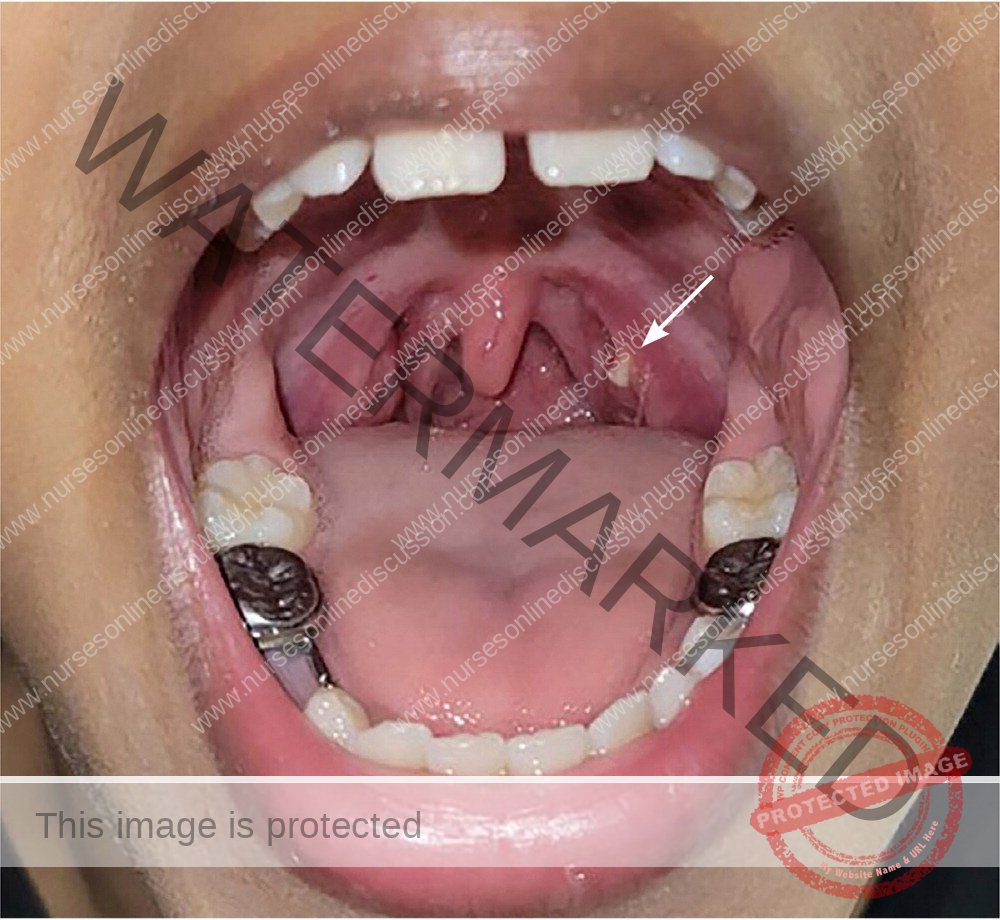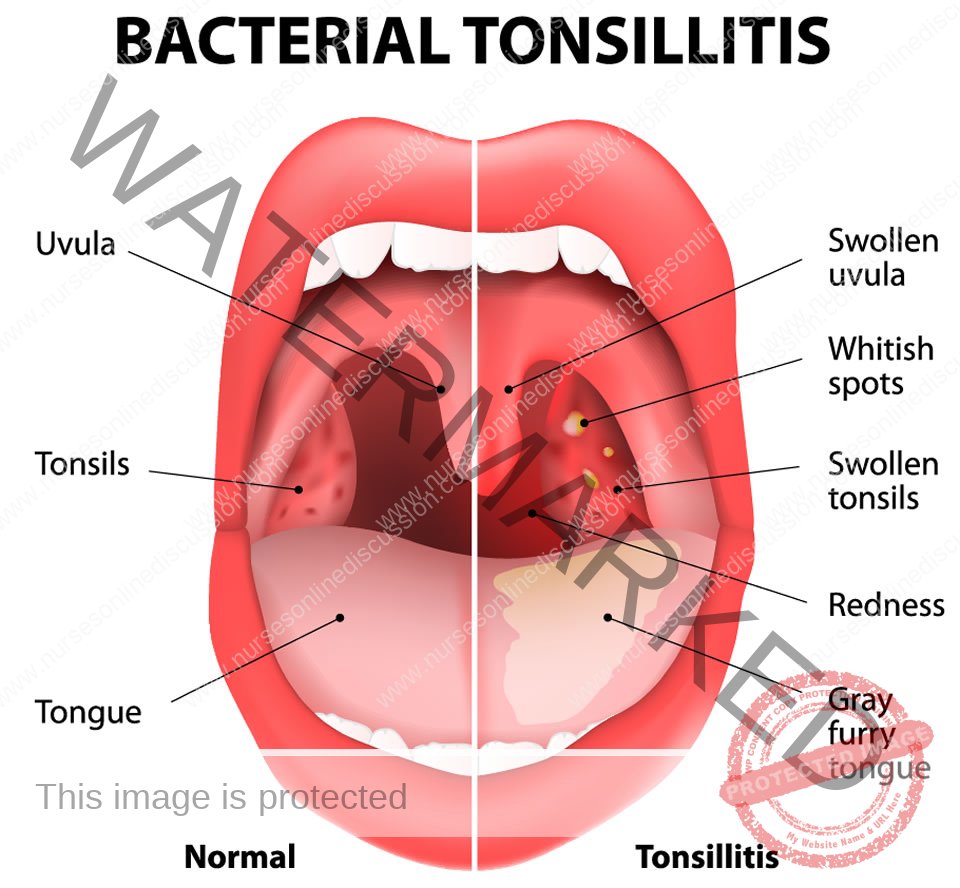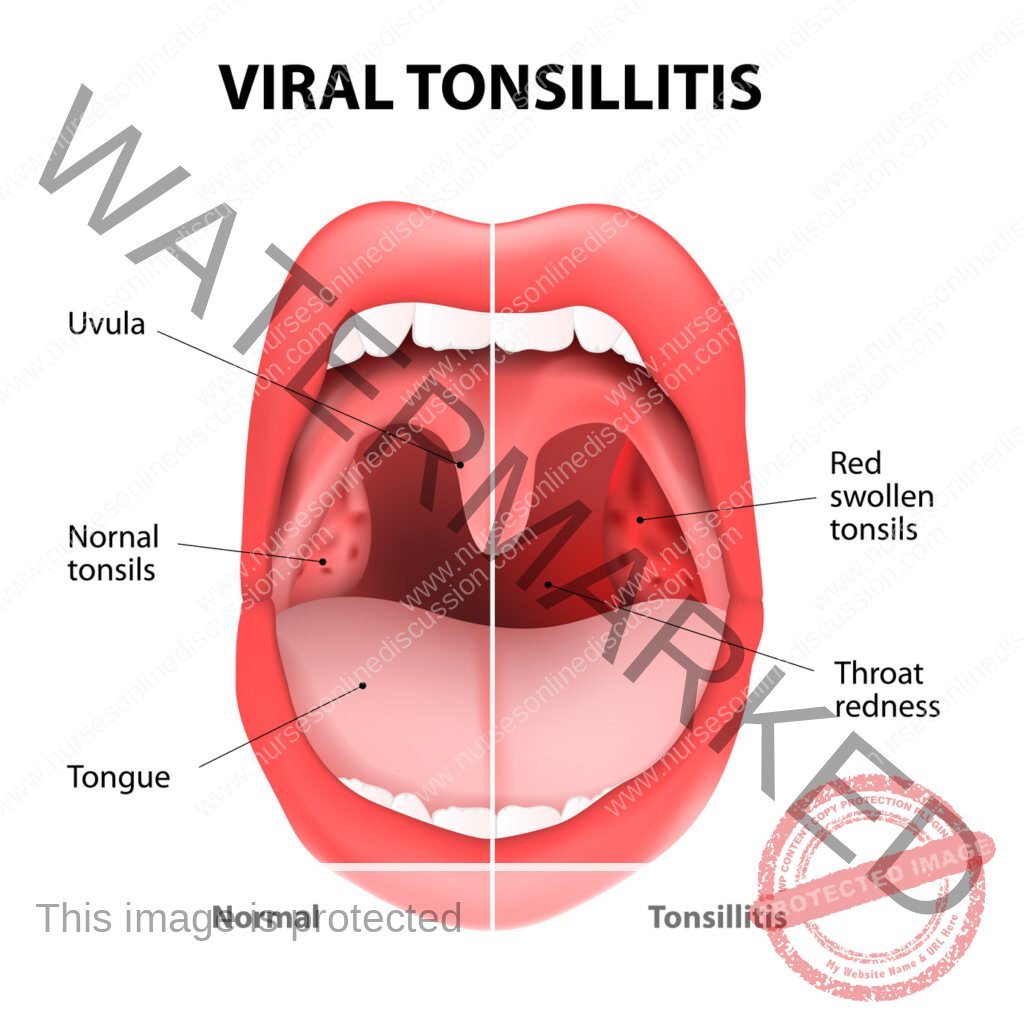Respiratory System Conditions
Subtopic:
Tonsillitis
Tonsillitis
- Tonsillitis refers to the inflammation of the tonsils. The tonsils are two oval-shaped masses of tissue situated at the rear of the throat, with one tonsil on each side.
- Tonsillitis is infectious and can be easily spread, particularly before noticeable symptoms appear.
- The tonsils play a protective role by capturing pathogens that could otherwise enter the respiratory system and cause bodily infection.
- They are also involved in the production of antibodies, which help fight off infections. Tonsillitis can present as either a sudden, short-term condition (acute) or a long-lasting or recurring problem (chronic).

Tonsils
- Tonsils are composed of a collection of lymphatic tissue, positioned on either side of the oropharynx, which is the middle part of the throat.
- Their primary function is to act as a component of the body’s defense system.
- Specifically, tonsils contribute to the body’s ability to resist infection by trapping invading pathogens.
Causes of tonsillitis
- Tonsillitis can arise from viral infections, often associated with the common cold. Indeed, viruses are the most frequent cause of tonsillitis, resulting in what is known as viral tonsillitis. The same viruses responsible for the common cold are often the culprits behind tonsillitis; however, various other viruses can also cause this condition. These include rhinoviruses, the Epstein-Barr virus (EBV), the hepatitis A virus, and the human immunodeficiency virus (HIV).
- Given that the Epstein-Barr virus is capable of causing both infectious mononucleosis (mono) and tonsillitis, individuals with mono may subsequently develop tonsillitis as a secondary bacterial infection.
- Another significant cause of tonsillitis is bacterial infection. The bacterium most commonly associated with tonsillitis is Streptococcus pyogenes (which causes strep throat); however, other bacterial species can also be responsible.
- Tonsillitis is particularly prevalent in children within the age range of 5 to 15 years.
- The tonsils, being composed of lymphatic tissues, are particularly susceptible to acute infections due to their role in the immune system and their location in the throat.


Types of tonsillitis
There are two primary classifications of tonsillitis:
Acute tonsillitis: This is a sudden inflammation of the tonsils.
Chronic tonsillitis: This indicates a persistent or recurring inflammation of the tonsils.
ACUTE TONSILLITIS (Recurring): This involves a sudden and widespread inflammation of the tonsils, frequently accompanied by inflammation of the surrounding arches (fornices) and the pharynx (sore throat). It is more common in children than adults and is typically caused by Group A Beta-hemolytic Streptococcus bacteria, although viruses can also be responsible.
CHRONIC TONSILLITIS: This is characterized by a persistent, ongoing inflammation of the tonsils. If acute episodes recur frequently, such as 5-6 times a year, it suggests that the individual has not developed adequate immunity, and the condition is considered chronic.
CLINICAL FEATURES OF TONSILLITIS
The signs and symptoms of tonsillitis can include:
- Sudden onset of symptoms.
- Sore throat, often severe.
- Fever and shivering chills.
- Snoring due to airway obstruction caused by swollen tonsils.
- Headache and vomiting.
- Difficulty and pain while swallowing (dysphagia).
- Enlarged tonsils, often with pus or white/yellow spots (exudates).
- Swollen and tender lymph nodes in the neck.
- Excessive production of saliva.
- Bad breath (halitosis).
- Neck stiffness and unexplained weight loss, particularly in chronic cases.
- Sometimes a cough and stuffy nose, more common in viral tonsillitis.
Diagnosis and investigations
The diagnostic process for tonsillitis involves:
- Gathering the patient’s medical history.
- Performing a physical examination of the throat, including palpating the neck to check for enlarged lymph nodes.
- Collecting a pus swab from the back of the throat for culture and sensitivity (C/S) to identify the causative organism (Throat swab).
- Drawing blood for a complete blood count (CBC) to help determine if the cause is bacterial or viral, guiding appropriate treatment.
Management of tonsillitis can be either Medical or Surgical, depending on the severity and frequency of the condition.
Aims of Management
- The goals of managing tonsillitis include:
- Limiting or preventing the spread of infection.
- Alleviating signs and symptoms such as pain and fever.
- Treating the underlying cause of the infection.
- Preventing potential complications.
Medical Management
Admit the patient to a medical isolation ward and implement strict isolation and barrier nursing to prevent the spread of infection.
Reassure the patient and their family members.
Monitor vital signs (temperature, pulse, respiration, and blood pressure) and specific indicators such as the degree of tonsil enlargement.
Reduce high fever using tepid sponging (applying lukewarm water to the skin).
Administer medications: Antibiotics, particularly penicillin (e.g., Penicillin V 500mg every 6 hours for 10 days), are used if the cause is bacterial. Antibiotics are ineffective against viral tonsillitis.
Provide analgesics, such as aspirin tablets, to relieve pain and reduce fever.
Instruct the patient to gargle with normal saline (saltwater).
Encourage the intake of plenty of oral fluids (at least 4-5 liters in 24 hours) and maintain good oral hygiene through regular mouth gargling.
Provide routine daily nursing care as required for any patient.
If the patient is a child, support their neck during swallowing.
Offer a highly nourishing diet that is soft and easy to swallow, gradually advancing the diet as tolerated.
Ensure frequent oral care to maintain mouth hygiene.
Special Observations
Observe for facial swelling (oedema) in the morning, which may suggest kidney inflammation (nephritis).
Monitor for painful joints, which could indicate rheumatic fever.
Observe and monitor fluid intake and output for decreased urine production and the presence of protein in the urine (albuminuria).
Continue to monitor for other potential complications.
Surgical Management (only for chronic tonsillitis)
- Surgical intervention, specifically a tonsillectomy, is considered for the management of chronic tonsillitis. However, simple enlargement of the tonsils without frequent infections is not typically an indication for removal, as tonsils in children are naturally larger and tend to decrease in size with age.
- Pre-operative management is similar to that for any surgical procedure.
Tonsillectomy
- Tonsillectomy is the surgical removal of the tonsils. It is indicated for severe, chronic tonsillitis, instances where the condition chronically interferes with schooling or daily life due to frequent recurrences, and when there is a concern for complications arising from the disease.
- The surgery is performed under general anesthesia, during which the tonsils are carefully dissected from the underlying pharyngeal tissue.
- Pre-operatively, the patient undergoes standard preparation for general anesthesia, with a particular emphasis on oral care and the administration of prophylactic intravenous antibiotics such as ceftriaxone.
Post-Operative care
- After the patient is transferred to the operating room, a post-operative bed is prepared with all necessary equipment.
- Post-operatively, the patient is positioned on their side in a recovery position with the head slightly lowered to prevent the inhalation of blood or tonsil fragments, thus avoiding aspiration. This position is maintained until the patient is fully alert.
- Regular post-operative observations, including temperature, pulse, respiration, and blood pressure, are carried out.
- The patient’s skin color is monitored, and they are observed for signs of bleeding, which may be indicated by frequent swallowing. Significant bleeding may require the patient to return to the operating room to have the bleeding points surgically tied off (ligation).
- The patient is encouraged to spit out secretions rather than swallow them.
- Antibiotics are administered to prevent or treat infections, such as intravenous ceftriaxone post-operatively, or oral penicillin V if the tonsillitis was acute.
- The day after surgery, the patient is encouraged to drink fluids and eat soft foods.
- Oral care, preferably using warm saline water for gargling, is encouraged. Once the patient’s condition improves, they are discharged with appropriate advice.
Complications of tonsillitis
- Untreated or severe tonsillitis can lead to several complications, including:
- Rheumatic fever, an inflammatory disease affecting the heart, joints, brain, and skin.
- Nephritis, inflammation of the kidneys.
- Asthma, exacerbation of respiratory symptoms.
- Peritonsillar abscess (quinsy), a collection of pus behind the tonsil.
- Peritonsillar cellulitis, a bacterial infection of the tissue surrounding the tonsils.
- Otitis media, middle ear infection.
Complications following tonsillectomy
- Hemorrhage (bleeding) is the most common immediate complication after a tonsillectomy.
- Secondary bacterial infections in the surgical site.
Get in Touch
(+256) 790 036 252
(+256) 748 324 644
Info@nursesonlinediscussion.com
Kampala ,Uganda
© 2025 Nurses online discussion. All Rights Reserved Design & Developed by Opensigma.co

